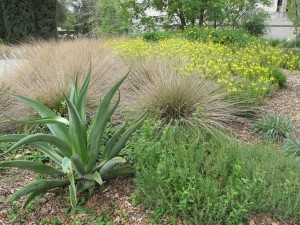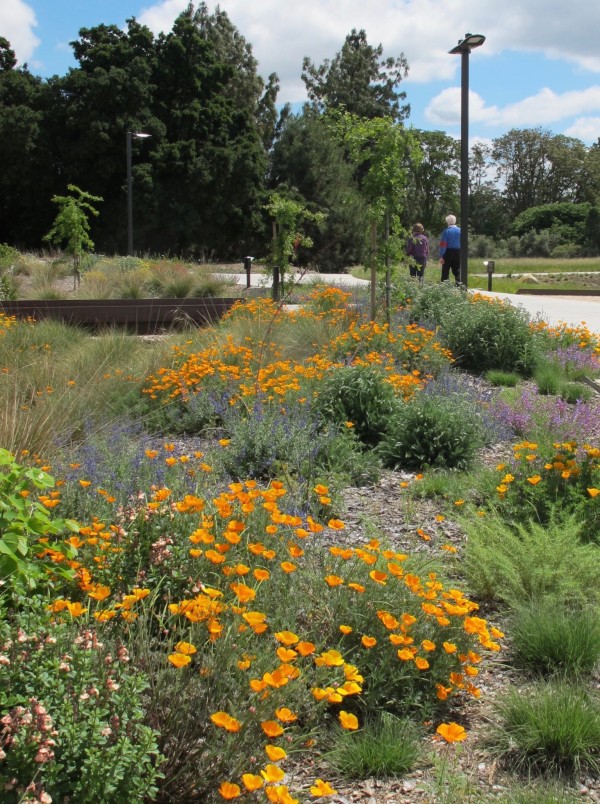
Mix and match plantings for interest and easy care

You may have noticed new and unique landscapes driving around campus or parking your car. They are sprouting up near the Arboretum, but outside its traditional boundaries; these gardens are the culmination of multiple years of working with low-water, easy-care, regionally-appropriate plants that perform well given our soil, climate and water type. Created by GATEways Horticulturist Ryan Deering along with our campus landscape architects, Sustainable Horticulture Learning by Leading students, talented volunteers, and accomplished Grounds and Landscape Services staff, these landscapes demonstrate the craft of designing interesting landscapes from a relatively short list of ornamental plants combined in different ways to create dramatic displays.
Within the Arboretum, the thematic classifications of our gardens and collections limit the variety of what we can plant together; we don’t usually have the freedom to demonstrate the particular combinations featured in these new landscapes. For example, we have gardens that are all Arboretum All-Stars, all California natives, all plants native only to Australia and New Zealand … the list goes on. So think of these new gardens as demonstration areas of sustainable plantings without preset restrictions.
You’ll find bunchgrasses, succulents and colorful flowering perennials that you’ve probably seen elsewhere in the Arboretum, but not necessarily together. These landscapes are another example of how you can create attractive, sustainable alternatives to high-water, low-environmental-value turf. They will not only command year-round interest, these plants are considered “one and done” — a term Ryan has coined to mean that they only require once-a-year maintenance.
So, when you are looking for easy inspiration, venture just outside the Arboretum and enjoy these landscapes throughout the year. You will see them pop in early spring when waves of purple penstemon contrast against bright orange poppies, then note the gradual shift to summer-blooming fuchsias, fall-blooming sages, and winter-blooming poker plants. In these landscapes you will find larger masses of fewer plants studded with architectural elements like Agave and unexpected focal points of color — plants Ryan calls “exclamation points” of the garden — like coral yucca and globes of allium.

Surrounding the Putah Creek Lodge parking lot, northeast of our Arboretum Teaching Nursery, is a great new planting that not only supports butterflies and native bee species, its grass-filled swales help filter storm water runoff. This large and diverse planting uses the year-round structure of pine muhly to frame the seasonal color of early-, mid- and late-season flowering perennials. Blanket flower (Gaillardia hybrids), California poppies (Eschscholzia californica), Salvia clevelandii and Santa Margarita Foothill Penstemon (Penstemon heterophyllus‘Margarita BOP’) paint this garden orange and blue in spring. This splash of color is followed by yellow yarrows, (Achillea ‘Moonshine’), dwarf lavenders and tall, waving, rounded purple flower heads of tall verbena (Verbena bonariensis)and elephant garlic (Allium ampeloprasum var. ampeloprasum). Long-blooming white guara (Guara lindheimeri) dangles delicate white-tinged pink flowers to help blend and unite the plantings through to the late season. California fuchsia and the fall bloom of autumn sage (Salvia × jamensis) will finish off the show when they draw the iridescent flashes of visiting hummingbirds.
In the Mrak Hall Circle an edge of pine muhly (Muhlenbergia dubia), Blue Hill wood sage (Salvia × sylvestris ‘Blauhügel’) and dainty, dancing white gaura (Guara lindheimeri) flowers contrast against the circle’s curvy border and egghead sculptures.

South of Mrak Hall, you will find an edge of pine muhly (Muhlenbergia dubia), Blue Hill wood sage (Salvia × sylvestris ‘Blauhügel’) and dainty, dancing white gaura (Guara lindheimeri) flowers to contrast against its curvy border. What you don’t see in the photo below, but what weaves its way through the middle, is a river of cheery yellow and red blanket flowers (Gaillardia hybrid). As summer comes, this bed will mimic the warmth of the season as California fuchsia (Epilobium canum) emerges with its bright, orange-red blooms.
by Ellen Zagory, Director of Public Horticulture and Katie Hetrick, Director of Marketing and Communications | UC Davis Arboretum and Public Garden
